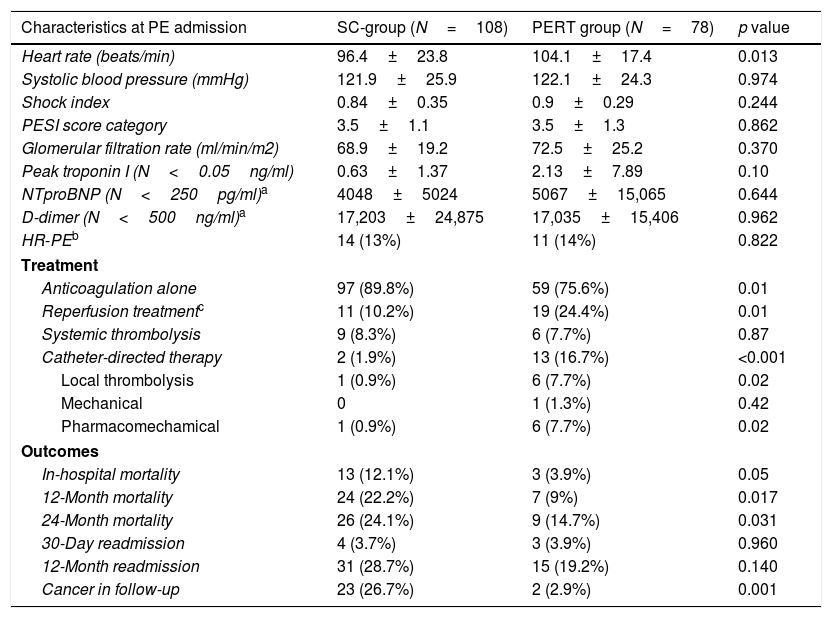Pulmonary embolism (PE) response teams (PERT) for the management of high-risk PE (HR-PE) and intermediate-high risk PE (IHR-PE) are encouraged in PE guidelines. We aimed to assess the impact of a PERT initiative on mortality in these groups of patients, compared with standard care.
MethodsWe conducted a prospective, single-center registry, including consecutive patients with HR-PE and IHR-PE with PERT activation from February-2018 to December-2020 (PERT group, n=78 patients) and compared it with an historic cohort of patients admitted to our hospital in a previous 2-year period (2014–2016), managed with standard of care (SC-group, n=108 patients).
ResultsPatients in the PERT group were younger and less comorbid. The risk profile at admission and the percentage of HR-PE was similar in both cohorts (13% in SC-group and 14% in PERT-group, p=0.82). Reperfusion therapy was more frequently indicated in PERT-group (24.4% vs 10.2%, p=0.01), with no differences in fibrinolysis treatment, while catheter-directed therapy (CDT) was more frequent in PERT group (16.7% vs 1.9%, p<0.001). Reperfusion and CDT were associated with lower in-hospital mortality (2.9% vs 15.1%, p=0.001 for reperfusion and 1.5% vs 16.5%, p=0.001 for CDT). The primary outcome, 12-month mortality, was lower in the PERT-group (9% vs 22.2%, p=0.02), There were no differences in 30-day readmissions. In multivariate analysis PERT activation was associated with lower mortality at 12 months (HR 0.25, 95% confidence interval 0.09–0.7, p=0.008).
ConclusionA PERT initiative in patients with HR-PE and IHR-PE was associated with a significant reduction in 12-month mortality compared with standard of care, and also with an increase in the use of reperfusion, especially catheter-directed therapies.
Las guías de manejo de embolia pulmonar (EP) recomiendan organizar equipos de respuesta a la embolia pulmonar (PERT) para el manejo de la EP de riesgo intermedio-alto (EP-IAR) y de alto riesgo (EP-AR). Nuestro objetivo fue evaluar el impacto de una iniciativa PERT sobre la mortalidad en estos pacientes, en comparación con la atención estándar.
MétodosRealizamos un registro prospectivo unicéntrico, incluyendo pacientes consecutivos con EP-IAR y EP-AR con activación del PERT desde febrero de 2018 hasta diciembre de 2020 (grupo PERT, n=78 pacientes) y lo comparamos con una cohorte histórica de pacientes ingresados en nuestro hospital en un período previo de 2 años (2014-2016), manejados con atención estándar (grupo SC, n=108 pacientes).
ResultadosLos pacientes del grupo PERT eran más jóvenes y con menos comorbilidades. El perfil de riesgo al ingreso y el porcentaje de EP-AR fue similar en ambas cohortes (13% en el grupo SC y 14% en el grupo PERT, p=0,82). La terapia de reperfusión fue más frecuentemente indicada en el grupo PERT (24,4% vs. 10,2%, p=0,01), sin diferencias en el uso de fibrinólisis, mientras que la terapia dirigida por catéter (CDT) fue más frecuente en el grupo PERT (16,7% vs. 1,9%, p<0,001). La reperfusión y la CDT se asociaron con una menor mortalidad hospitalaria (2,9% vs. 15,1%, p=0,001 para reperfusión y 1,5% vs. 16,5%, p=0,001 para CDT). El objetivo primario, la mortalidad a los 12 meses, fue menor en el grupo PERT (9% frente al 22,2%, p=0,02). No hubo diferencias en los reingresos a los 30 días. En el análisis multivariado la activación de PERT se asoció con una menor mortalidad a los 12 meses (hazard ratio 0,25, intervalo de confianza del 95%: 0,09-0,7, p=0,008).
ConclusiónUna iniciativa PERT en pacientes con EP-IAR y EP-AR se asoció con una reducción significativa en la mortalidad a los 12 meses en comparación con el tratamiento estándar y también con un aumento en el uso de la reperfusión, especialmente de las terapias dirigidas por catéter.











